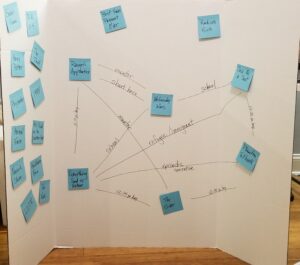Often the best way to do discuss books effectively is to not plan it all out ahead of time. Megan’s family started with a motif journal and discovered ways to make interesting organic connections between books.
The unplanned, laid-back book club
Last summer I started a teen book club without a plan. So far we have read The Wednesday Wars, The Giver,…….
When we read Radium Girls, someone mentioned that the corporation was dehumanizing people. A-ha! Where else have you seen evil corporations? Have you read any other books that dehumanize people? We came up with a few titles on the spot.
Evil corporations:
- Radium Girls
- The Magic Bicycle series
- The Pushcart War
Dehumanizing people:
- Radium Girls
- The Hiding Place
- The Giver
Later I started playing with book mapping. After reading Radium Girls I read The Woman Who Split the Atom, which reminded me not only of Radium Girls but also of Bomb and Number the Stars. When I read a variant of “Little Red Riding Hood” to my boys, they brought up several comparisons with other fairy tales (Goldilocks is a little girl who wanders in the wood) and variants (lots of alternative versions in Looney Tunes!).
Books and relationships

Isn’t it interesting how mightily we are drawn to relationships and connections? Seems we were designed that way.
I wondered if it was only intriguing for me and my family, because we are used to thinking about books this way, or if the teens in our book club would enjoy it too. All I needed was a three dollar tri-fold presentation board, a stack of Post-it notes, and a sharpie to find out.
At the next meeting we brainstormed all the titles we had discussed so far and I slapped Post-its randomly on the board. (Please note that I hadn’t prepared anything in advance.) After we discussed our current selection, I asked them if they noticed any connections between the books we had already read.
They noticed settings (school), characters (immigrants/refugees), and narrative style (episodic, non-linear narrative). They noticed short heroes (remember the motif?) and the presence of a mentor.
I couldn’t be more pleased with the effortless results of simply paying attention over time.
How do you lead a book discussion without really trying? Start with a book you like. Then read another one. Do they have anything in common? Maybe they do, maybe they don’t. Then read another book…and don’t overthink it.
Support our writers and help keep Redeemed Reader ad-free by joining the Redeemed Reader Fellowship.
Stay Up to Date!
Get the information you need to make wise choices about books for your children and teens.
Our weekly newsletter includes our latest reviews, related links from around the web, a featured book list, book trivia, and more. We never sell your information. You may unsubscribe at any time.
We'd love to hear from you!
Our comments are now limited to our members (both Silver and Golden Key). Members, you just need to log in with your normal log-in credentials!
Not a member yet? You can join the Silver Key ($2.99/month) for a free 2-week trial. Cancel at any time. Find out more about membership here.

